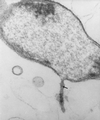Isolation and characterization of BTF-37: chromosomal DNA captured from Bacteroides fragilis that confers self-transferability and expresses a pilus-like structure in Bacteroides spp. and Escherichia coli
- PMID: 11790742
- PMCID: PMC139536
- DOI: 10.1128/JB.184.3.728-738.2002
Isolation and characterization of BTF-37: chromosomal DNA captured from Bacteroides fragilis that confers self-transferability and expresses a pilus-like structure in Bacteroides spp. and Escherichia coli
Abstract
We report the isolation and preliminary characterization of BTF-37, a new 52-kb transfer factor isolated from Bacteroides fragilis clinical isolate LV23. BTF-37 was obtained by the capture of new DNA in the nonmobilizable Bacteroides-Escherichia coli shuttle vector pGAT400DeltaBglII using a functional assay. BTF-37 is self-transferable within and from Bacteroides and also self-transfers in E. coli. Partial DNA sequencing, colony hybridization, and PCR revealed the presence of Tet element-specific sequences in BTF-37. In addition, Tn5520, a small mobilizable transposon that we described previously (G. Vedantam, T. J. Novicki, and D. W. Hecht, J. Bacteriol. 181:2564-2571, 1999), was also coisolated within BTF-37. Scanning and transmission electron microscopy of Tet element-containing Bacteroides spp. and BTF-37-harboring Bacteroides and E. coli strains revealed the presence of pilus-like cell surface structures. These structures were visualized in Bacteroides spp. only when BTF-37 and Tet element strains were induced with subinhibitory concentrations of tetracycline and resembled those encoded by E. coli broad-host-range plasmids. We conclude that we have captured a new, self-transferable transfer factor from B. fragilis LV23 and that this new factor encodes a tetracycline-inducible Bacteroides sp. conjugation apparatus.
Figures







Similar articles
-
Characterization of BctA, a mating apparatus protein required for transfer of the Bacteroides fragilis conjugal element BTF-37.Res Microbiol. 2007 Sep;158(7):600-7. doi: 10.1016/j.resmic.2007.06.004. Epub 2007 Jul 13. Res Microbiol. 2007. PMID: 17720457
-
Bacteroides fragilis transfer factor Tn5520: the smallest bacterial mobilizable transposon containing single integrase and mobilization genes that function in Escherichia coli.J Bacteriol. 1999 Apr;181(8):2564-71. doi: 10.1128/JB.181.8.2564-2571.1999. J Bacteriol. 1999. PMID: 10198023 Free PMC article.
-
Conjugal transfer of antibiotic resistance factors in Bacteroides fragilis: the btgA and btgB genes of plasmid pBFTM10 are required for its transfer from Bacteroides fragilis and for its mobilization by IncP beta plasmid R751 in Escherichia coli.J Bacteriol. 1991 Dec;173(23):7471-80. doi: 10.1128/jb.173.23.7471-7480.1991. J Bacteriol. 1991. PMID: 1657890 Free PMC article.
-
Isolation and characterization of cLV25, a Bacteroides fragilis chromosomal transfer factor resembling multiple Bacteroides sp. mobilizable transposons.J Bacteriol. 2002 Apr;184(7):1895-904. doi: 10.1128/JB.184.7.1895-1904.2002. J Bacteriol. 2002. PMID: 11889096 Free PMC article.
-
Resistance factors in anaerobic bacteria.Scand J Infect Dis Suppl. 1986;49:56-63. Scand J Infect Dis Suppl. 1986. PMID: 3029859 Review.
Cited by
-
Interaction of Bacteroides fragilis pLV22a relaxase and transfer DNA with Escherichia coli RP4-TraG coupling protein.Mol Microbiol. 2007 Nov;66(4):948-60. doi: 10.1111/j.1365-2958.2007.05967.x. Epub 2007 Oct 5. Mol Microbiol. 2007. PMID: 17919288 Free PMC article.
-
Mobile genetic elements in the genus Bacteroides, and their mechanism(s) of dissemination.Mob Genet Elements. 2011 Sep;1(3):187-196. doi: 10.4161/mge.1.3.18448. Epub 2011 Sep 1. Mob Genet Elements. 2011. PMID: 22479685 Free PMC article.
References
-
- Anthony, K. G., C. Sherburne, R. Sherburne, and L. S. Frost. 1994. The role of the pilus in recipient cell recognition during bacterial conjugation mediated by F-like plasmids. Mol. Microbiol. 13:939–953. - PubMed
-
- Ausubel, F. M., R. Brent, R. E. Kingston, D. D. Moore, J. G. Seidman, J. A. Smith, and K. Struhl (ed.). 1998. Current protocols in molecular biology. John Wiley and Sons, New York, N.Y.
Publication types
MeSH terms
Substances
LinkOut - more resources
Full Text Sources
Molecular Biology Databases
Miscellaneous

